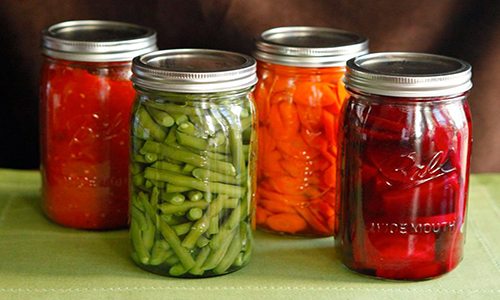Home food preservation has been making a comeback in a big way. Many people with gardens at home are finding it beneficial to preserve the extra produce instead of letting it go to waste. While home food preservation can take quite a bit of time, the end result is well worth the work.
Safety has long been the main concern when it comes to food preservation. Food poisoning can occur if proper procedures and supplies are not used during the process. Here are a few basic tips to get you started.
First, be sure to use a recipe that has been tested for safety. Many recipes have been passed down through generations and while no one may have had food poisoning from it yet, it simply is not safe. One resource for recipes that have been tested for safety would be the National Center for Home Food Preservation housed at the University of Georgia. Visit their website at http://nchfp.uga.edu/ for recipes, step by step food preservation instructions and tips for success. The Ball Blue Book is another resource for recipes and can readily be found at many retailers in the community.
It is also important to leave the recipes just the way they are. Adding or removing ingredients can alter the acidity levels and therefore cause an unsafe product. Altering the amount of acid in a recipe is not recommended. When recipes call for vinegar, you can safely substitute lemon juice for the vinegar. However, this does not work vice versa. Lemon juice cannot be replaced by vinegar as this will decrease the acidity level and potentially cause an unsafe product.
Use only the recommended materials and make sure that they are in good condition. The jars should be free of nicks and cracks. They should also be the type of jar that you will find in the canning section at the store. These jars, such as the Ball or Kerr brand jars, come with two-piece lids including the flat and ring. Old mayo jars and others of that nature should not be used. If used in a pressure canner they could crack or even explode under the pressure. Jars specifically made for home food preservation can withstand the pressure and heat. Others have not been tested to do so. The jar rings should not be bent and should be free of rust. While the rings can be reused if in good condition, the flats can only be used one time. Each and every canned item should have a new flat.
Be sure to know which method (and which equipment) to use before you begin to insure a safe product. Most people seem to be fearful of using a pressure canner and opt to water bath can their foods. However, it comes down to one main point: Follow the directions/procedures step by step! Many pressure canners come with directions for use. It is also important to understand what foods can be processed in a water bath canner and what foods need to be processed in a pressure canner. Products with higher acidity levels, such as salsa, can be processed in a water bath. For foods with lower acidity levels, pressure canning is a must.
If you have food preservation questions or would like more information regarding food preservation workshops, contact your local MU Extension county office or search for classes in your area on the MU Extension website.







